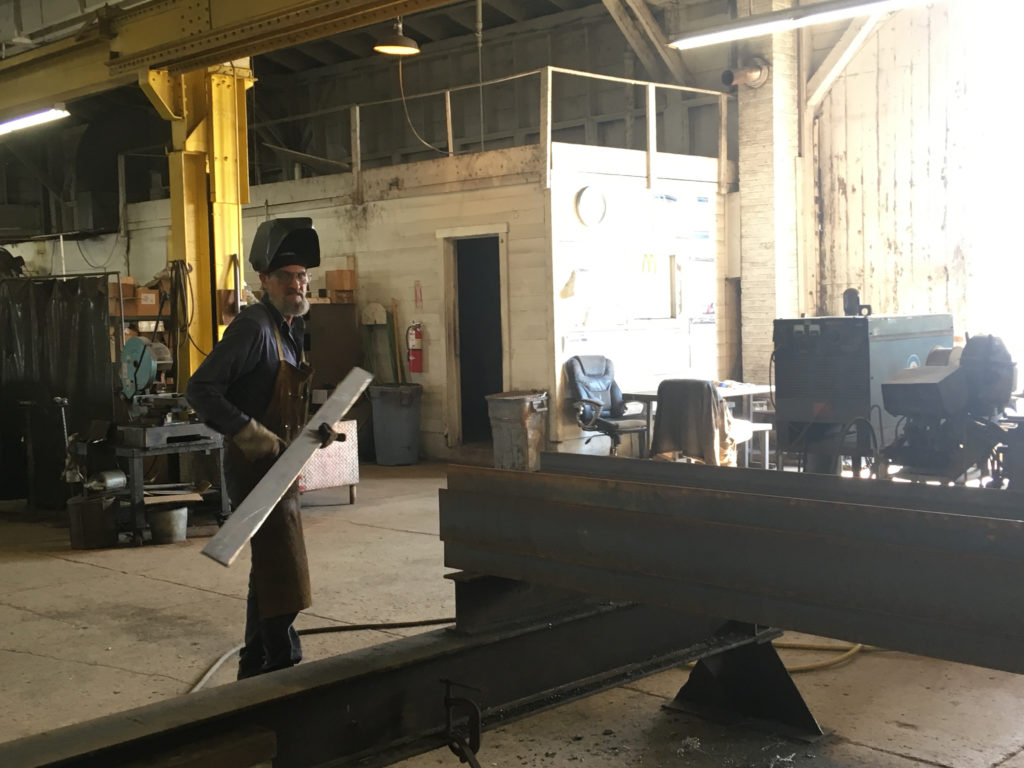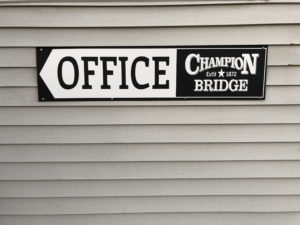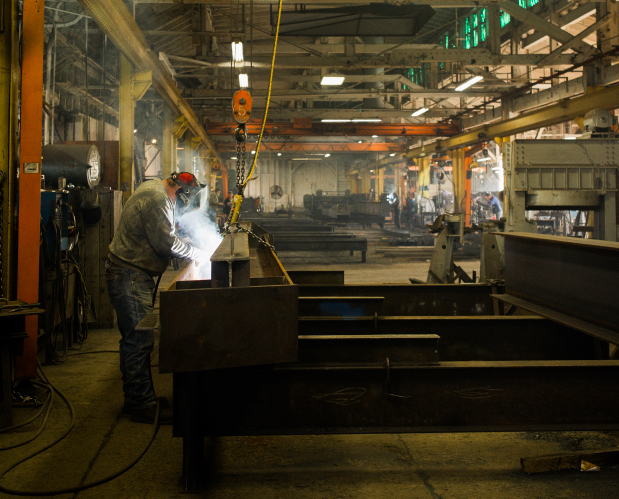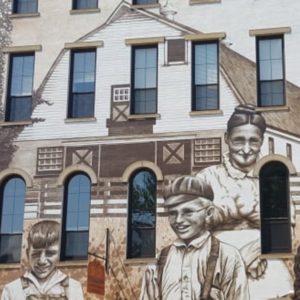In the small town of Wilmington, OH, just a block off Main Street, a 62-year-old white-bearded welder named Bob Christman lifts a steel beam as deftly as someone half his age. He’s worked at Champion Bridge steel fabrication for 14 years and, like the company, he has no interest in slowing down.
But that may not be up to Bob, or to the Dell family that owns the nearly 150-year-old company. Champion Bridge, the city of Wilmington, and their rural corner of Ohio all tell the story of the impact of President Donald Trump’s economic policies — the good and bad.
Champion Bridge is a small company with fewer than 20 employees, but they are proud to work on big projects for the Chillicothe Veterans Affairs Medical Center and the Wright-Patterson Air Force Base in Dayton, Ohio. The owners, the Dell family, also pride themselves on buying local materials and working on local projects.

Bob Christman works the floor at Champion Bridge in Wilmington, OH / Photo: Kate Patrick / InsideSources
For the Dells and for Wilmington, steel fabrication isn’t just a job, it’s interwoven with the fabric of rural life in southwest Ohio. In a small town like Wilmington, where manufacturing constitutes 20 percent of private sector employment, local businesses right downtown like Champion Bridge are part of the city’s DNA.
Randy and Diane Dell and their family have lived in area for generations. In early October, Diane helped out at the front desk after the Champion Bridge lost its secretary. This past summer, second son Isaac ripped out the old, unused railroad tracks behind the shop that once carried trains laden with raw materials to Champion Bridge.
Noah Dell, the eldest son, is a project manager. He manages the day-to-day work and bids project estimates to potential customers. As he walks through the shop in the heart of downtown Wilmington talking to welders and cutters, an unusually warm October sun streams through open windows and doors to illuminate steel work that’s been part of the city for more than 100 years. The noise of the machines fill the cavernous shop, and it sounds like a bustling industrial factory, even with a relatively small staff.
Champion Bridge sits on East Sugartree Street, which is one block over from Main, a stone’s throw away from the city’s BMV and behind Sugartree Ministries — which houses the coffee shop and music venue Joe’s Java and serves the homeless and addicted with free meals and clothing.
Champion Bridge is the oldest building on the block and could use an update. The doors and the walls and the beams are aged and weary, but Champion Bridge may not be able to renovate any time soon.
Dell originally believed the Tax Cuts and Jobs Act (TCJA) would provide enough savings for Champion Bridge to renovate its 125-year-old building. But now he fears that any benefits of tax reform may be outweighed by the consequences of President Trump’s steel tariffs and other economic forces.
“We came into the year with a lot of hope and optimism with the tax cuts. We did see a direct impact on our savings, and it lowered our tax rate a lot,” Dell said. And, he says, there was “lots of activity” in the steel industry in 2018’s first quarter. But once the steel tariffs went into effect—along with new regulations on the trucking industry—the surge tapered off. Now materials costs for Champion Bridge are now up 20 percent, a price increase higher than any in recent memory.

A sign points the way to the steel fabrication company’s office in Wilmington, OH / Photo: Joanna Dell
For Dell, this means hesitant clients and less savings. And if tariffs and other economic forces drive their prices higher, it may make competition with foreign steel fabricators more difficult.
“All employees at every business want fair wages, but overseas you can pay them a dime a day, so how are we supposed to compete?” Mack Culbertson, a new welder told InsideSources. He’s eight months into the job and a faithful Trump supporter.
Lost savings and business won’t hurt just Champion Bridge, but the city as well. The effects of the tariffs could continue to set back a rural area that must work twice as hard to compete in a globalized economy that favors America’s coastal cities.
According to The American Institute of Steel Construction (AISC) — of which Champion Bridge is a member–it’s hard to say whether the price increase of steel is due to tariffs, the booming U.S. economy, or both.
“A lot of people are quick to say those are due specifically to the tariffs, and we’re still in a booming construction economy, there are several industries like energy and gas that are really strong right now,” AISC’s Director of Government Affairs Brian Raff told InsideSources. “Tariffs play a small role in the way the market is handling these things. Historically if you look at the way pricing has been, we’re still well below where prices topped out in 2008. I think the market is just reaching equilibrium.”
When President George W. Bush enacted steel tariffs in 2002 — at a 5 percent higher rate than Trump’s — economic data shows they had a minuscule negative effect on the U.S. economy overall.
That doesn’t mean the tariffs aren’t hurting business, though. Earlier this year, experts predicted the tariffs would hit the Rust Belt hardest — the very people and industries Trump says he’s trying to help (and who also happen to be his voter base).
Raff said the AISC does not support or oppose tariffs. The association lobbied on behalf of steel fabricators in order to make the tariffs fairer for the steel industry, he said.
He also thinks the general market uncertainty swirling around Trump’s erratic behavior is affecting steel prices. Businesses aren’t confident about how the economy will look a month or even a week from now, so they’re hedging their bets and prices are skyrocketing.
“I think there’s a lot of uncertainty about where these tariffs are going and whether there’s a long-term strategy, when the tariffs are going to go away or who is going to get another exemption,” he said. “There’s a lot of swirling, unanswered questions, and uncertainty in general breeds a chaotic marketplace. Once some of those questions are answered I think we’ll see some settling down.”
Raff thinks the answer is a federal infrastructure bill — which still hasn’t been detailed, despite promises from the White House at the beginning of the year — that would stimulate the steel industry with big building projects.
“If we could get a transportation bill passed that would have a much more positive impact and boost the steel industry more than tariffs,” he said.

The shop floor at Champion Bridge metal fabricators in Wilmington, OH / Photo: Joanna Dell
Champion Bridge has always bought domestic steel — Dell said it’s their industry standard — so the tariffs didn’t dramatically disrupt its supply chain other than hike steel prices. Instead, outside forces disrupted the company’s supply chain. Dell believes some of that 20 percent jump in materials costs can be attributed to higher freight costs.
The extremely high truck driver turnover rate has created a severe driver shortage across the U.S. That, the booming economy and rising interest rates are causing freight rates to skyrocket, and those costs are getting passed to companies like Champion Bridge.
“The impact we have seen is the shortage in trucking,” Dell said. “We recently purchased a project and there were some large beams that had to come directly from the mill, and normally those beams can come in a couple days, and in this case the beams were done, at the mill, ready to be delivered, but it took almost two weeks to get a truck.”
One of the steel mills Champion Bridge uses — Newport Mill in Texas — recently had more than 200 loads ready to ship that they “couldn’t get trucks for,” Dell said.
Dell now has a “legitimate concern” that the effects of higher materials costs caused by the tariffs and a tumultuous freight industry could wipe out the benefits of the TCJA. “Every job that we’re quoting now, we’re passing on all the cost increases,” he said.
But for some jobs he bid before the tariffs went into effect, the quote doesn’t reflect the materials costs post-tariffs. For those, Champion Bridge has lost about $5,000 to $8,000 in materials costs per project. For small companies like Champion Bridge, those are big numbers.
Dell fears that for companies like his that rely on steel, tariffs could cost them business.
“If steel prices rise higher than wood and concrete, then contractors and designers could start moving toward wood and concrete and away from steel,” Dell said. “You start pulling all these levers and they have unintended consequences.”
For now, Noah Dell remains optimistic. After a slow second and third quarter, he expects business to start picking up again soon and the volatility to even out to a normal year except for a bad month or two.
“It seems like late third quarter a lot of projects broke loose,” he said. “It hurts the most when it’s really volatile.”

